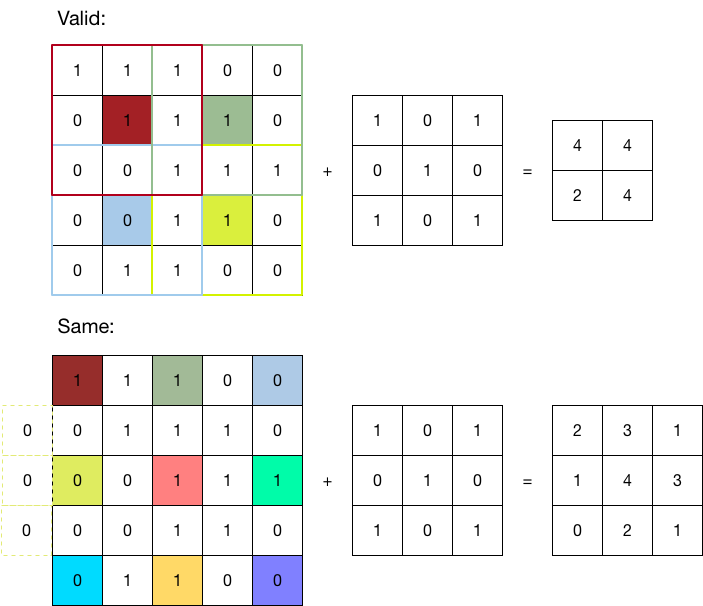TensorFlow-卷积
卷积:
conv2d (
input,
filter,
strides,
padding,
use_cudnn_on_gpu=True,
data_format='NHWC',
name=None
)
|
参数名 |
必选 |
类型 |
说明 |
|
input |
是 |
tensor |
是一个 4 维的 tensor,即 [ batch, in_height, in_width, in_channels ](若 input 是图像,[ 训练时一个 batch 的图片数量, 图片高度, 图片宽度, 图像通道数 ]) |
|
filter |
是 |
tensor |
是一个 4 维的 tensor,即 [ filter_height, filter_width, in_channels, out_channels ](若 input 是图像,[ 卷积核的高度,卷积核的宽度,图像通道数,卷积核个数 ]),filter 的 in_channels 必须和 input 的 in_channels 相等 |
|
strides |
是 |
列表 |
长度为 4 的 list,卷积时候在 input 上每一维的步长,一般 strides[0] = strides[3] = 1 |
|
padding |
是 |
string |
只能为 " VALID "," SAME " 中之一,这个值决定了不同的卷积方式。VALID 丢弃方式;SAME:补全方式 |
|
use_cudnn_on_gpu |
否 |
bool |
是否使用 cudnn 加速,默认为 true |
|
data_format |
否 |
string |
只能是 " NHWC ", " NCHW ",默认 " NHWC " |
|
name |
否 |
string |
运算名称 |
实例代码:
import tensorflow as tf a = tf.constant([1,1,1,0,0,0,1,1,1,0,0,0,1,1,1,0,0,1,1,0,0,1,1,0,0], dtype=tf.float32,shape=[1,5,5,1]) b = tf.constant([1,0,1,0,1,0,1,0,1], dtype=tf.float32,shape=[3,3,1,1]) c = tf.nn.conv2d(a,b,strides=[1, 2, 2, 1], padding='VALID') d = tf.nn.conv2d(a,b,strides=[1, 2, 2, 1], padding='SAME') with tf.Session() as sess: print ("c shape:") print (c.shape) print ("c value:") print (sess.run(c)) print ("d shape:") print (d.shape) print ("d value:") print (sess.run(d))
不同padding参数的不通运行方式与结果:

实验来源于 腾讯云 - 开发者实验室 中TensorFlow API的相关实验;
有意思的是,上述实验结果与给出的参考结果完全不同,有感兴趣的好同志不妨试试看到底是谁出错了。




 浙公网安备 33010602011771号
浙公网安备 33010602011771号